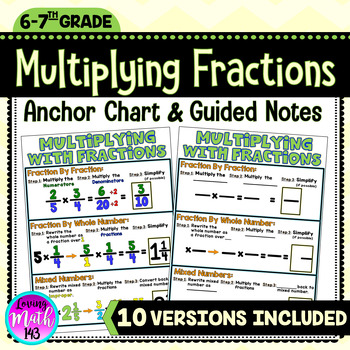Multiplying Fractions and Mixed Numbers Anchor Chart Poster and Guided Notes
What educators are saying
Also included in
- This Bundle of sixth grade math reference sheets are designed and aligned with 6th grade math! Fractions, Decimals, Ratios, Proportions, Expressions, Equations, Combining like terms, and more! Pretty much everything students need to know and understand for 6th grade. They make for excellent scaffolPrice $82.20Original Price $102.75Save $20.55
- This Bundle of sixth grade math reference sheets are designed and aligned with 6th grade math! Fractions, Decimals, Ratios, Proportions, Expressions, Equations, Combining like terms, and more! Pretty much everything students need to know and understand for 6th grade. They make for excellent scaffolPrice $105.00Original Price $134.25Save $29.25
- These middle school math anchor chart posters are a great scaffold or tool to display in your classroom and/or distribute to students to place in their interactive math notebook and/or binders. Students will be reminded that when dividing fractions they must multiply by the reciprocal. I also includPrice $15.00Original Price $19.00Save $4.00
Description
If your students struggle multiplying fractions and mixed numbers then these anchor charts and guided notes are for you! This is the perfect reference for students who are learning how to multiply a fraction by a fraction, a fraction by a whole number, and mixed numbers. A perfect tool to display in your classroom, print as an individual anchor chart or use as interactive guided notes for your students notebook and/or binder! Each version can be used as a scaffold and/or tool for struggling students.
WHATS INCLUDED:
★ Multiplying Fractions Anchor Chart Poster
★ Fraction by Fraction:
- Multiply the Numerators, Multiply the Denominators, Simplify.
★ Fraction by a Whole Number:
- Rewrite the whole number as a fraction over 1, multiply, simplify.
★ Mixed Numbers:
- Rewrite mixed number as improper, multiply, convert back to mixed numbers.
***********************************************************************************************
WHATS INCLUDED:
★ Colored Version of each anchor chart - Perfect to print and display on your classroom bulletin board and/or Math Word Wall.
★ Black-and-white Version of each Anchor Chart - Perfect for use if you do not have a colored printer! Simply print this version on colored paper to have bright anchor charts!
★ Mini Version of each Anchor Chart - Perfect for students to tape and/or glue into their interactive math notebooks. You may also choose to use this as a scaffold, or tool, during independent practice.
★ Interactive Version of each Anchor Chart - Partially filled in anchor charts that students can complete as a whole class and/or independently using their knowledge.
***********************************************************************************************
HOW TO USE:
This anchor chart can be printed on a regular 8.5 x 11 inch printing paper. You can also scale the PDF file and print it on poster size paper and display it within your classroom. That is how I use my anchor charts.
***********************************************************************************************
LICENSING TERMS: This purchase includes a license for one teacher only for personal use in their classroom. Licenses are non-transferable, meaning they can not be passed from one teacher to another. No part of this resource is to be shared with colleagues or used by an entire grade level, school, or district without purchasing the proper number of licenses.
COPYRIGHT TERMS: This resource may not be uploaded to the internet in any form, including classroom/personal websites or network drives, unless the site is password protected and can only be accessed by students.








